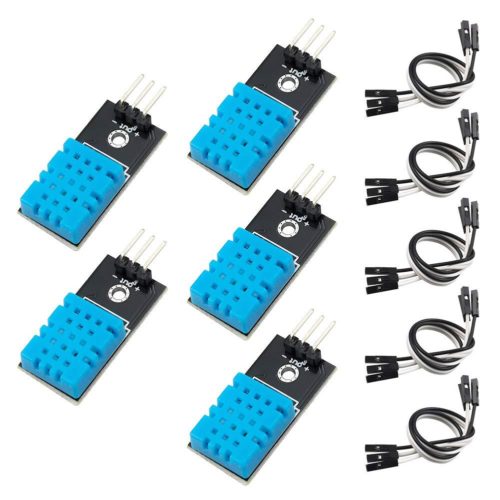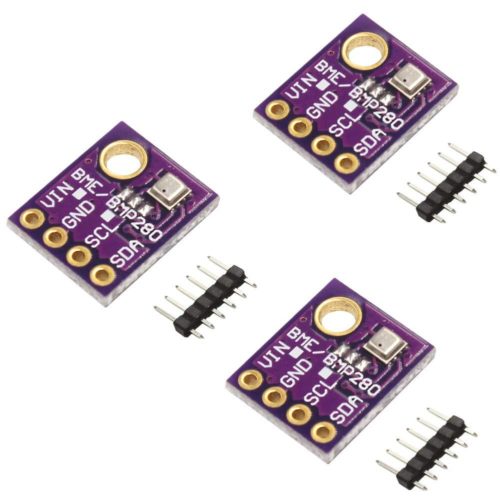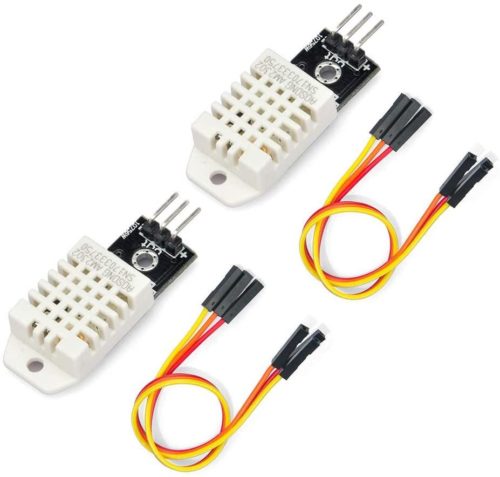The sensors are awesome! They let you know what’s happening in the outside world. Temperature and humidity sensors, in particular, are some of the most widely employed instruments in various monitoring applications.The reason is that these are the most critical measurements to get right when you are trying to create safe and energy-efficient environments. That is why they’re extensively used in agriculture, health, biomedical, meteorological, food processing, and pharma industries, to name a few.
In this article, we reviewed the best temperature and humidity sensor modules for Arduino. You can use these sensors in a variety of applications and implement multiple IoT projects in beginner as well as professional settings. As different sensors are manufactured for different applications, we’re not ranking them from best to worst for this write-up.
If you have no idea where to start, take a look at the included buyer’s guide section for help.
So, without further ado. Let’s get right into it!
KeeYees 5pcs DHT11 Temperature Humidity Sensor Module

DHT11 is perhaps the most popular, widely used, and reliable temperature and humidity sensor module for Arduino based projects. It can measure humidity from 20% to 90% RH and temperature from 0 to 50 degrees Celsius.
The best thing about KeeYees DHT11 is that you can operate it with both 3.3 and 5 Volts power. This makes it suitable for connection to not just Arduino, but as well as other standard boards such as Raspberry Pi, RN Control, etc.
Besides operating voltage, you need only one other port to connect to the sensor module. It has a quick response time and comes with an anti-interference ability to reduce noise levels. During our tests, we found that the readings are reasonably accurate. While the first readings aren’t very accurate, the second, third, and subsequent calls showed precise numbers.
That said, the module has a reasonable cost and works best for most DIY projects. However, DHT11 feels somewhat outdated in 2020 for modern IoT applications. That is why we advise IoT professionals to look at other more up to date options mentioned in this article.
Buy Here: Amazon
SMAKN DHT22/AM2302 Digital Temperature and Humidity Sensor

This sensor is a wired version of the DHT22. It’s a basic high-end model of the DHT11, and slightly more expensive. But it has high measurement accuracy and outstanding long term stability. What’s more, it offers a wider temperature and humidity measurement range. In brief, the DHT22 steps in where DHT11 falls short.
It utilizes a capacitive humidity sensor (0 ~ 99.9%RH) and a thermistor (-40 ~ +80℃) to measure the surrounding air. It spits out a digital signal on the data pin with ±2%RH humidity and ±0.5℃ temperature accuracy. Yup, it needs no analog input pins. Therefore this sensor is ideal for monitoring room climate or building a DIY climate station in your backyard.
The module is relatively easy to use. In case you face any problem, the instructional ebook comes in very handy. It has detailed guidelines about how to start and operate this product. However, keep in mind that accurate data reading requires careful timing.
This module’s only downside is sending data every two seconds, which means sensor readings are not real-time, but two seconds old. However, this much delay is acceptable in most hobbyists, as well as some professional settings.
Buy Here: Amazon
KeeYees BME280 Temperature Humidity and Atmospheric Pressure Sensor

The KeeYees BME280s and their I2C interface are excellent little devices for gauging temperature, pressure, and humidity. They’re extremely fast in updating any changes in the environmental conditions. For instance, when you’re going from low humidity to high humidity, it instantly detects the difference. No waiting for slow sensors anymore! The package includes three pieces of the digital sensor module.
The LDO regulator offers great help in a mixed 5v and 3.3v environment. Its temperature humidity and operational pressure ranges are -40 to +85°C, 0-100%, and 300-1100 hPa, respectively, with +-1°C, +-3%, and +-1Pa accuracy.
The BME280’s online library has some great examples to play around with, but formatting them to work on an LCD screen is tough. Still, the precision and variety of measurements are totally worth the shot.
Overall, the BME280s is a great winter project to spend a couple of hours on. Its humidity and pressure readings are fairly accurate, but the temperature is slightly off. It works like a charm with Arduino based projects and ideal for RF24 and Wi-Fi sensor nodes.
Buy Here: Amazon
Gowoops 2 pcs DHT22 Temperature Humidity Sensor Module

The Gowoops DHT22 is a mainstay for anyone learning to play with different types of microcontrollers. It is tiny, reliable, and fetches decently accurate readings.
This lovely sensor has ± 2% relative humidity measurements with a range of 0–100% RH and ±0.5 degrees Celsius temperature accuracy at a range of -40 to +80°C. It operates on a DC voltage of 3 to 5.5 volts.
What we love about Gowoops DHT22 sensor is that it comes with an attached board. Hence, it eliminates the need to solder in the pins altogether. All you have to do is just plug it in and make something cool for your project. Moreover, it also comes with a cable to stretch the sensor away from the hardware if you want.
The only problem is that the sensor comes with absolutely no documentation. If you want to write your code Vs, utilize some of the Arduino, or C-libraries available online, be ready for your best detective work.
Buy Here: Amazon
Adafruit (PID 3251) Si7021 Temperature & Humidity Sensor Breakout Board

If you’re tired of DHT11 and DHT22 modules and want highly reliable temperature and humidity measurements for professional projects, then Adafruit Si7021 may be for you.
The measurements range from 0–80% RH for humidity and -10 to +85 °C for temperature. While it has a higher temperature accuracy of ±0.4 °C, humidity accuracy is understandably ± 3%. The sensor is neatly placed on a breakout board with a 3.3 Volts regulator and level shifting. Therefore, you can use it without any problem with 3.3V or 5V power. In addition, the board has a PTFE filter (the white flat thingy on top), which helps keep the sensor nice and clean.
It uses I2C for data transfers. Therefore it can work with a wide range of microcontrollers, not just Arduino. Besides wiring, it becomes fairly easy as you don’t need any resistors. Yes, the pins are a little tricky to get right the first time, and you do have to solder them on, but if a beginner like me can do the soldering part, then so can you.
All in all, the Adafruit Si7021 module is perfect for all of your environmental and ecological sensing projects, whether you’re a beginner or a professional.
Buy Here: Amazon
A Buyer’s Guide to the Best Temperature and Humidity Sensor Modules for Arduino
Temperature and humidity sensor modules have significant performance and price differences. So how do you pick the best module for your project at hand?
Measure Humidity and Temperature Accuracy
Of course, the accuracy of measurement is the most critical aspect of a humidity and temperature sensor. Highly accurate sensors tend to be more costly because precision requires a great deal of care in manufacturing. Usually, this information is written on the package when you purchase the product. But accuracy may vary depending on the environment you subject your sensor modules to. If there’s a lot of interference and the general atmosphere is harsh, then the module’s accuracy will obviously suffer. Still, it’s better to go for a module that offers more precision than one that provides a broader measurement range.
Measure Humidity and Temperature Range
The range of a sensor should be your second consideration. Generally speaking, the broader the range of humidity and temperature a sensor can detect, the higher will be its price. Therefore, select a module that meets your measurement range necessary for the projects. Moreover, except for scientific and meteorological research, you do not need full humidity range (0 to 100% RH) of measurement.
Protection
Most sensor modules are not water-resistant or waterproof. You’ll need to “engineer” some creative ways to keep them dry and away from harm’s way. But keep in mind that you cannot seal them so tight that it interferes with their ability to take samples. Some modules do come in a waterproof version, such as when you need a temperature sensor to measure the temperature of the water or any other liquid. But they’re far and few.
Final Thoughts
That’s all about the best temperature and humidity sensor modules for Arduino. We hope this guide was informative, and you got to learn some useful information. For routine everyday DIY projects, DHT11 will do just fine. Its humidity accuracy of 5 to 95 percent RH satisfies most applications. However, if your project needs higher accuracy, go for DHT22. For harsher environments with strong interference, BME280, PID 3251, or AM2311A are suitable. There are even better temperature and humidity sensors for industrial-grade applications such as AHT20. But they’re not intended for home use. That’s all for this article. Thank you for reading!
from Linux Hint https://ift.tt/35TzK2a



0 Comments